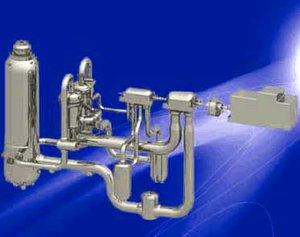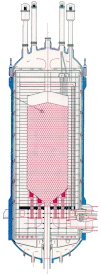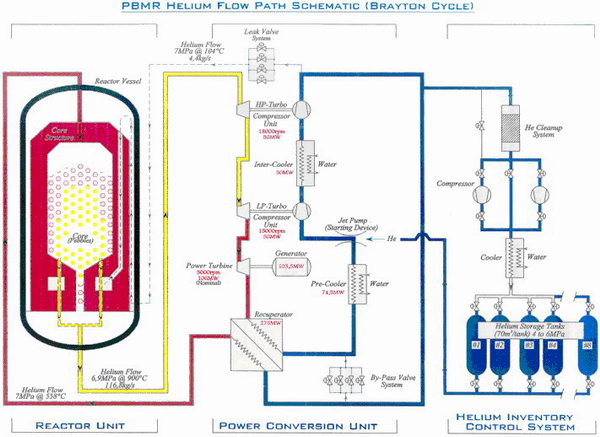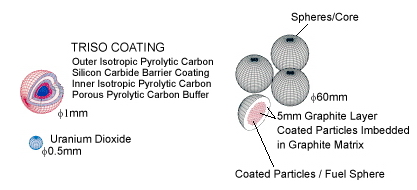

Chin Kai Qing(7)
Emily Chua(8)
Lei Simin(16)
Loh Ai Leng(21)
That Mrs Chua would love our blog
That Mrs Chua would give us a high grade for this SIA
That Mrs Chua would stay young,healthy and ever so beautiful forever
insert tagboard here
layout design, coding, photo-editing,
by ice angel
 From:
From:the beauty exposed ;
the beauty exposed ;



 PBR from www.pbmr.co.za |
 Reactor Interior – pebbles in red: www.eskom.co.za/ nuclear_energy/ pebble_bed/ pebble_bed.html |
 Internal functioning with cooling diagram: www.eskom.co.za/nuclear_energy/pebble_bed/pebble_bed.html |
 Fuel Spheres: www.eskom.co.za/nuclear_energy/pebble_bed/pebble_bed.html |


the beauty exposed ;
Principles of Nuclear Energy
Radiation
During the splitting of any other fission nucleus, radiation is produced. Any material producing radiation is called radioactive. There are four distinct types of radiation associated with nuclear fission, called alpha, beta, gamma and neutron radiation:
Alpha radiation
- Alpha radiation is a form of nuclear fission where the parent atom splits into two daughter products. It is a type of radioactive decay in which an atomic nucleus emits an alpha particle (two protons and two neutrons bound together into a particle identical to a helium nucleus) and transforms into an atom with a mass number 4 less and atomic number 2 less.[1] Alpha radiation is fundamentally a quantum tunneling process. Unlike Beta radiation, alpha radiation is governed by the strong nuclear force.
Beta Radiation
- Beta radiation is a type of radioactive decay in which a beta particle (an electron or a positron) is emitted. In the case of electron emission, it is referred to as "beta minus" (β−), while in the case of a positron emission as "beta plus" (β+). Kinetic energy of beta particles has continuous spectrum ranging from 0 to maximal available energy (Q), which depends on parent and daughter nuclear states participating in the decay. Typical Q is of order of 1 MeV(amount of energy equivalent to that gained by a single unbound electron when it is accelerated through an electrostatic potential difference of one volt, in a vacuum)[2], but it can be from few keV to few tens MeV. The most energetic beta particles are ultrarelativistic, with speeds very close to the speed of light.
Gamma radiation
- Gamma rays are the most dangerous form of radiation emitted by a nuclear explosion because of the difficulty in shielding them. This is because gamma rays have the shortest wavelength of all waves in the electromagnetic spectrum, and therefore have the most ability to penetrate through any gap, even a subatomic one, in a what might otherwise be a shield.[3]
- Gamma-rays are not stopped by the skin. They can induce DNA alteration by interfering with the genetic material of the cell. DNA double-strand breaks are generally accepted to be the most biologically significant lesion by which ionizing radiation causes cancer and hereditary disease. A study done on Russian nuclear workers exposed to external whole-body gamma radiation at high cumulative doses shows the link between radiation exposure and death from leukemia, lung, liver, skeletal and other solid cancers. Alongside radiation, gamma-rays also produce thermal burn.
Neutron Radiation
- The neutrons in reactors are generally categorized as slow (thermal) neutrons or fast neutrons depending on their energy. Thermal neutrons are similar to a gas in thermodynamic equilibrium but are easily captured by atomic nuclei and are the primary means by which elements undergo atomic transmutation.
In order to achieve an effective fission chain reaction, the neutrons produced during fission must be captured by fissionable nuclei, which then split, releasing more neutrons. In most fission reactor designs, the nuclear fuel is not sufficiently refined to be able to absorb enough fast neutrons to carry on the fission chain reaction, due to the lower cross section for higher-energy neutrons, so a neutron moderator must be introduced to slow the fast neutrons down to thermal velocities to permit sufficient absorption.[5] Common neutron moderators include graphite, light water and heavy water. A few reactors (fast neutron reactors) and all nuclear weapons rely on fast neutrons. This requires certain changes in the design and in the required nuclear fuel. The element beryllium is particularly useful due to its ability to act as a neutron reflector or lens. This allows smaller quantities of fissile material to be used and is a primary technical development that led to the creation of neutron bombs.
Principles of Thermodynamics
In thermal physics, thermal energy is the energy portion of a system that increases with its temperature. In thermodynamics, thermal energy is the internal energy present in a system in a state of thermodynamic equilibrium by virtue of its temperature. "thermal energy" can only be defined as any spontaneous flow of energy from one object to another, caused by a difference in temperature between two objects; thus, an object cannot possess "heat".This is explained by the second law of thermodynamics.
Internal energy is the sum of all microscopic forms of energy of a system. It may be viewed as the sum of kinetic and potential energies of the molecules; it consists of the following types of energies e.g. Nuclear energy, Sensible energy, Latent energy and chemical energy etc.
Nuclear energy is the tremendous amount of energy associated with the strong bonds within the nucleus atom itself. It is energy due to the splitting (fission) or merging together (fusion) of the nuclei of atoms.
Zeroth Law of Thermodynamics
- The Zeroth Law of Thermodynamics introduces the concept of thermodynamic equilibrium, in which two objects have the same temperature.
- If we bring two objects that are initially at different temperatures into physical contact, they eventually achieve thermal equilibrium.
- During the process of reaching thermal equilibrium, heat is transferred between the objects.
- The amount of heat transferred Q is proportional to the temperature difference T between the objects and the heat capacity c of the object. Therefore, the formula of the Zeroth Law is (Q = c ![]() delta T). [8]
delta T). [8]
- The heat capacity is the constant that tells how much heat is added per unit temperature rise.
- Therefore in the Zeroth Law, in the process of reaching thermodynamic equilibrium, heat is transferred from the warmer object to the cooler object. At thermodynamic equilibrium, heat transfer is zero.
First Law of Thermodynamics
- The First law is also known as the law of Conservation of Matter.
- The amount of work depends not only on the initial and final states of the gas but also on the process which produces the final state. The amount of heat transferred into or from a gas also depends on the initial and final states and the process which produces the final state.
- The difference of the heat flow into the gas and the work done by the gas depends only on the initial and final states of the gas and does not depend in the process which produces the final state.
- Therefore, the internal energy of the gas only depends on the state of gas and not on any process. The internal energy is a state variable, just like the temperature.[9]
- The First Law of Thermodynamics defines the internal energy as equal to the difference of the heat transfer into a system and the work done by the system.
- Any thermodynamic system in an equilibrium state possesses a state variable called the internal energy. Between any two equilibrium states, the change in internal energy is equal to the difference of the heat transfer into the system and work done by the system.
- Let E1 be the internal heat of the 1st object and E2 be the internal heat of the 2nd object. Q is the heat transfer between 2 objects and W is the work done of the 2 objects.[10]
- Therefore, the formula of the First Law of thermodynamics is E2 - E1 = Q – W.
Second Law of thermodynamics
- "Entropy" is defined as a measure of unusable energy within a closed or isolated system. As usable energy decreases and unusable energy increases, "entropy" increases. Entropy is also a gauge of randomness or chaos within a closed system. [6]As usable energy is lost, disorganization, randomness and chaos increase.
- The balance equation of the second law, expressed as S > 0, says that in all natural processes the entropy of the world always increases, and thus whereas with the first law there is no time, and the past, present, and future are indistinguishable, the second law, with its one-way flow, introduces the basis for telling the difference. [7]
- The Second Law of Thermodynamics states that "in all energy exchanges, if no energy enters or leaves the system, the potential energy of the state will always be less than that of the initial state."
- For example: A car that has run out of gas will not run again until you walk 10 miles to a gas station and refuel the car. Once the potential energy locked in carbohydrates is converted into kinetic energy, the organism will get no more until energy is input again. In the process of energy transfer, some energy will dissipate as heat. Entropy is a measure of disorder: cells are not disordered and so have low entropy. The flow of energy maintains order and life.
Third Law of Thermodynamic
- The Third Law of Thermodynamics says: "The entropy of a pure perfect crystal is zero (0) at zero Kelvin (0° K)."
- As the temperature of a system approaches absolute zero, its entropy approaches a constant (for pure perfect crystals, this constant is zero). A pure perfect crystal is one in which every molecule is identical, and the molecular alignment is perfectly even throughout the substance. For non-pure crystals, or those with less-than perfect alignment, there will be some energy associated with the imperfections, so the entropy cannot become zero.[11]
- In other words, a body at absolute zero could exist in only one possible state, which would possess a definite energy, called the zero-point energy. This state is defined as having zero entropy
(1) Free energy generators and the 2nd law of thermodynamics; Dr. Veniamin Filimonov http://www.cold-nuclear-fusion.com/articles/
free-enegry-generator.html
Date accessed:
(2) How Nuclear Radiation Works © 1998-2008 HowStuffWorks, Inc. http://science.howstuffworks.com/nuclear2.htm
Date accessed:
(3) Gamma Radiation;
Date accessed:
(4) Beta Particles; U.S Environmental Protection Agency Last updated:
http://www.epa.gov/radiation/understand/
beta.html
Date accessed:
(5) Nuclear Power Fundamentals http://www.tpub.com/content/doe/h1019v1/
css/h1019v1_89.htm
Date accessed:
(6) Frank L. Lambert, Professor Emeritus (2008) Entropy and the Second Law of Thermodynamics [on-line]
www.2ndlaw.com/ (
(7) AllAboutScience.org (--) Second Law of Thermodynamics [on-line]
www.allaboutscience.org/second-law-of-thermodynamics.htm (
(8) M.J. Farabee (2001) LAWS OF THERMODYNAMICS [on-line]
http://www.emc.maricopa.edu/faculty/farabee/BIOBK/BioBookEner1.html (
(9) Pidwirny, M. (2006). "Laws of Thermodynamics". Fundamentals of Physical Geography, 2nd Edition [on-line]
www.physicalgeography.net/fundamentals/6e.html (
(10)National Aeronautics and Space Administration, Tom Benson, (2006) First Law of Thermodynamics [on-line]
www.grc.nasa.gov/WWW/K-12/airplane/thermo1.html (
(11)Splung.com (2007) The Third Law of Thermodynamics [on-line]
http://www.splung.com/content/sid/6/page/thirdlaw (
the beauty exposed ;




the beauty exposed ;
the beauty exposed ;
Pressurized Water Reactors
Source: ICJT (--) ICJT.org - Nuclear Power Plants in the World [2]
Boiling Water Reactors
 Source: ICJT (--) ICJT.org - Nuclear Power Plants in the World [2]
Source: ICJT (--) ICJT.org - Nuclear Power Plants in the World [2]| State | Percent |
| | 73.7 |
| | 51.2 |
| | 50.7 |
| | 48.9 |
| | 47.8 |
| | 46.0 |
This is the U.S. Nuclear Generating Statistic from 2004 to 2007
| Year | Total Electricity Generation (MWh) | Nuclear Generation (MWh) | Nuclear Fuel Share (Percent) | Capacity Factor (Percent) | Summer Capacity (MW) | |
| 2004 | 3,970,555,289 | 788,528,387 | 19.9 | 90.1 | 99,628 | |
| 2005 | 4,055,422,744 | 781,986,365 | 19.3 | 89.3 | 99,988 | |
| 2006 | 4,064,702,228 | 787,218,636 | 19.4 | 89.6 | 100,334 | |
| 2007* | 4,159,513,913 | 806,486,978 | 19.4 | 91.8 | 100,334 | |
Source: Global Energy Decisions/Energy Information Administration
Updated on 4/08
Here are some other figures of the number of operating nuclear power plants in the world [4]
Top 5 States - Operating Nuclear Power Plants [4]
Top 5 States - % of Electricity from Nuclear Power Plants [4]
However, these figures are up to date of 2005. As of a World Nuclear Industry Status Report 2007 to date of
As of the total number of nuclear reactors in the world, they provided around 15 percent of the world's electricity production in 2007. [6] Overall, 16 countries relied on nuclear energy to generate at least one-quarter of their total electricity supply. Below is the table of countries generating the largest percentage of their electricity in 2007 from nuclear energy.
| Country | Percent |
| | 76.8 |
| | 64.4 |
| | 54.3 |
| | 54.0 |
| | 48.1 |
| | 46.1 |
| | 43.5 |
| | 41.6 |
| | 40.0 |
| | 36.8 |
| | 35.3 |
| | 32.1 |
Citings:
[1] Nuclear Energy Institute (2008) Nuclear Energy Institute - U.S. Nuclear Power Plants [on-line] http://www.nei.org/resourcesandstats/nuclear
_statistics/usnuclearpowerplants/ (
[2] ICJT (--) ICJT.org - Nuclear Power Plants in the World [on-line]
http://www.icjt.org/an/tech/jesvet/jesvet.htm (
[3] Nuclear Energy Institute (--) Nuclear Energy Institute - State Nuclear Facts [on-line]
http://www.nei.org/publicpolicy/stateactivities
/statenuclearfacts/ (
[4] Patricia A. Michaels (2005) World Nuclear Power Statistics 2004 [on-line] http://greennature.com/article275.html (
[5] Mycle Schneider, Paris and Antony Froggatt,
/206/206808.pdf (
[6] Nuclear Energy Institution (--) Nuclear Energy Institute - World Statistics [on-line] http://www.nei.org/resourcesandstats/nuclear
_statistics/worldstatistics/ (
Kaiqing (7) Elvendork!!!
the beauty exposed ;